This cabinet card portrait was made by photographer George James Maddison, whose studio was at 9 Norfolk Road in Dalston, which is in the London Borough of Hackney. (In 1938 Norfolk Road was renamed Cecilia Road.) Information on the website photoLondon suggests he may have been the son of John Maddison, a photographer and retired baker. However, I haven’t been able to confirm that relationship using census records.

Among the boys, we can see tennis rackets and cricket bats, which don’t normally appear in school photos in the late Victorian era. In this first detail image, some of the male teachers are posing confidently together:

Detail #2:

Some of the school’s support staff were also included in the portrait, as we can see in the open window below. I’m curious about the little basket on the table in the center of the image. Does anyone know what it might have been used for?

Detail #4:

It looks like it might have been a fun place to go to school!

Post updated July 15, 2021 (photographer identified).

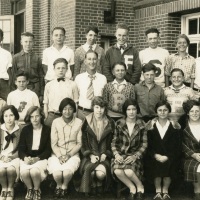

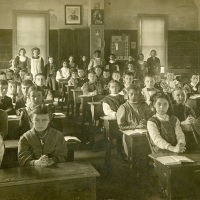

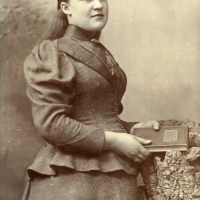
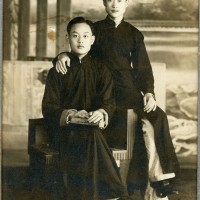

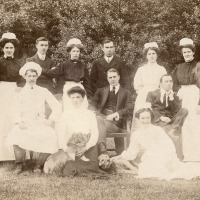


Try this https://images.app.goo.gl/XuYz3E8basvN9ANk8
LikeLiked by 1 person
That’s the only other photo I saw, and the owner didn’t add any information about the photographer. Maddison must not have stayed in business very long. Thanks, CJ!
LikeLiked by 1 person
I love the support staff peering from the shadows out of the window!
LikeLiked by 2 people
Haha, yes, it’s not entirely clear whether they actually wanted to be in the picture or not!
LikeLiked by 1 person
Makes it all the more interesting!
LikeLiked by 1 person
An interesting and varied group! This would have been a day school, rather than a boarding school?
LikeLiked by 1 person
In the middle of London, it could certainly have been either. I was thinking boarding school, but day school might make more sense. One avenue of inquiry might be to look into schools which offered cricket and tennis. They must have had plenty of space, or access to club facilities.
LikeLiked by 1 person
Good point!
LikeLiked by 1 person
Cool photo!
My first thought about the metal basket on the table is that it’s a letter or document tray. The rather dyspeptic, older woman sitting behind the table, taking a place in the center of the group, may have been the head of the school (what we would call the principal), and perhaps that was placed there as a symbol of her position?
LikeLiked by 1 person
Because of the way I cropped the detail images, it isn’t obvious, but the only two adult women in the group are seated on either side of the little table with the basket. That certainly isn’t a coincidence. One thing I find curious is that there are so many more boy pupils than girls. If there were only boys, that would make more sense. Maybe it was a summer school with an emphasis on athletics?
LikeLike
Brad, is it possible that that ornamental basket was used to carry the two books shown in this tableau.
One book – quite big but probably fitting into the basket at some angle – is on a table on our right. The book is lying in such a way that you could think that it has been awarded to the confident student whose elbow is on the table and who is not carrying any sports paraphernalia.
The second is lying open in front of a boy in a striped blazer on our left. He is the central character in a grouping of 3. The boys on either side of him are either leaning towards him or are all but pointing to – perhaps – the book. This (possible) awardee looks rather pleased too.
Perhaps this was a prize giving of sorts and the books the prize carried outside in that ornamental basket?
Sarah
LikeLiked by 2 people
You may be right, Sarah, about the photo being taken after an award ceremony marking the end of the school term. That would make sense. You mentioned a book in front of the boy in stripes at lower left. I’m pretty sure that’s a cricket bat! It’s hard to see because of the orientation of the bat. That would explain the boy’s striped shirt. In contrast, the two boys with tennis rackets are dressed appropriately in white. 🙂
LikeLiked by 1 person
Yes, I see it now: definitely not a book. Once I saw one book, I began to look for others and must have persuaded myself that a bat is a book.
All the more likely, I suppose, that that one book is a prize.
The ratio of adults to children is amazing, also.
The other point of great note is the presence of a man among the teachers, perhaps, of a man from the Asian subcontinent. A teacher. I imagine relatively rare now even now given their actual numbers in the British population, let alone then before war and after revolutionary movement against British rule in India/Pakistan had begun. Quite interesting, this!
Sarah
LikeLiked by 1 person
I’m very glad you mentioned him! I wonder if his hat gives a clue as to his national or ethnic background? I also thought he looked South Asian. Wouldn’t it be interesting to know his story?
LikeLike
I noticed the books too, and assumed they were connected to the basket in some way: perhaps functionally, or perhaps as symbols of something else. The greenery looks somewhat staged as well. Whatever the occasion, it clearly demanded some preparation. Since Maddison billed himself as an “art photographer,” perhaps all of it — basket, books, ivy — were his contribution. Perhaps he staged the scene as well as taking the photo.
LikeLiked by 1 person
I have a theory–with no factual support of any kind–that G.J. Maddison may have been a woman. Women photographers tended to use their initials or their husband’s name–e.g., Mrs. Williams–and sometimes billed themselves as specialists in working with children. These are purely circumstantial arguments. I’d love to find some evidence! It would also explain the dearth of records–if she married and changed her name.
LikeLiked by 1 person
What a splendid photograph! Striped blazers, straw boaters, sailor’s attire, fob-watches and pocket handkerchiefs. It’s delicious in it’s Victorian-ness! They all have quite a self-satisfied air about them, except for the staff peeking through the window – a class apart. Another typical feature of Victorian life.
LikeLiked by 2 people
You’re so right, Tracey! My first draft of the post began with: “There’s so much to see in this photograph!” The photo conveys something of the spirit of the time–the leisure pursuits, the formality of the clothing, the confident poses, and–as you mention–a glimpse of the class structure that made this society possible. The teachers were probably somewhere in the middle of that social hierarchy.
LikeLike
Agreed! This photo strikes me as “peak” Victorian.
Why did striped blazers ever go out of style? They look carefree in a way.
LikeLiked by 2 people
I bet some guys still wear them in certain settings. You’d have to have the right hat to go with the blazer….
LikeLiked by 1 person
Maybe we should start a movement…. bring them back!
LikeLiked by 2 people
Interesting photo. Well, I don’t know if the school was in Dalston,but I know – or knew – Dalston, as some of my family lived there and I visited them often when I was young, and I went to a college in the area, for a couple of years in the 1960s, too! Even though there are a few girls in the photo, my guess is it was a boys’ or predominantly boys’ primary school. In later times Dalston was very seedy and run-down, but in the days in which this photo was taken, it might have been more middle-class in some of the schools. By the way, the postcode of ‘N.E.’ no longer exists there, and hasn’t for any part of my lifetime (that I know of), instead, it’s E.8. (East 8).
The wrought-iron basket would most likely have been for flowers or potted plants – one pot on either side of the handle, or the flowers laid lengthways after cutting, beneath the handle. Here, it’s obviously just serving as a prop but I don’t doubt it belonged to the school. Here’s the sort of thing you can look for if you do any research on it: https://www.aubaho.de/uk/garden/garden-furniture/shelf/2994/set-flower-basket-plant-container-firewood-iron-fruit-antique-style-brown. The straight, horizontal handle in your photo reminds me of the old wrought-iron containers for tools for maintaining indoor (hearth) fires, such as a poker, shovel, etc.
Hope some of that helps, if I think of anything else, I’ll let you know!
LikeLiked by 1 person
That’s a great suggestion about the basket, and I definitely think you’re right about the school being oriented toward boys. I wasn’t even sure if it was a school, because of all the sporting equipment. But a school seems the most likely scenario.
How neat that you’ve had connections to Dalston. You also commented very knowledgeably about Islington on an earlier post of mine.
LikeLiked by 1 person
Yes, I knew Islington well, too. I knew quite a lot of London (but it changed a lot in later years.) I’m originally from East London, moved later to North London – then here to Wales! Quite a move, that one!
I had some more thoughts about your photo here and showed it to my husband. We both agree that it’s most likely to be a Prep (Preparatory) school, and probably private. It looks upper-class. Also the rackets look like they are for Squash rather than tennis and that was/is played indoors. I gather it was ‘invented’ by mistake in Harrow School (a well-known public school – public schools here are actually private, fee paying ones.) and then it became popular in other schools. But I doubt it was ever played in anything other than a school for wealthy kids. There are also cricket bats. I thought at first that they might have been Rounders bats (it’s like Baseball), but then spotted the ones to the right that have the familiar squared-ends.
Oh and the studio would have been named after St Mark’s Church which is very close to the studio, in a street called St Mark’s Rise (I used to take a bus through St Mark’s Rise very frequently!)
Also, don’t know if you’ve spotted it (I zoomed in) but the card was printed in Berlin. Maybe you can track down more by looking for the name of the printers?
Thanks for the follow to my new blog.
LikeLiked by 1 person
I just had a look at Street View, starting on Cecilia Road. I found #11, so presumably #9 is the door to the left. An interesting neighborhood! Slightly gritty, but most houses are very well-kept and attractive: https://www.google.com/maps/@51.5486721,-0.0681694,3a,30y,272.27h,89.96t/data=!3m6!1e1!3m4!1s7l5zRFl9hbxL2_MgJUsD7Q!2e0!7i16384!8i8192
Now I need to read your post about the new block editor. 🙂
LikeLike
By the way, my userpic and the URL to my blog is for a new blog I’m starting… it shouldn’t actually be showing yet (and I thought I’d logged out of that account!) so I think something may have gone wrong…. but never mind. This is Val from Colouring the Past!!
LikeLiked by 1 person
Your new gravatar pic is fabulous!! I’ve had the same one since I started (more than three years). I should really shake things up, but it’s more fun to put energy into new posts. I look forward to your new blog!
LikeLiked by 1 person
There really are some interesting details in this one, especially the sports gear and the South Asian teacher.
LikeLiked by 1 person
Thank you! School photos are a favorite category of mine, but they can start to look alike after a while, especially if the kids are dressed in normal clothes. This one really stands out!
LikeLiked by 1 person
Let us hope that it was a fun place to go to school. It certainly must have been an interesting mixture. They look properly behaved for a photo.
LikeLiked by 1 person
Hi Jo Nell! Your comment went into my spam folder, which is weird, because you’ve commented before. Oh well. Nice to hear from you! Brad
LikeLike
I agree; quite a lot to see in this photograph! Even though the facial expressions are so serious, it’s seems like it was a harmonious group.
LikeLiked by 1 person
Most of them do look serious! I imagine there were lots of pressures on these kids and lots of rules to follow. With so many teachers watching them, they probably couldn’t get away with much!
LikeLiked by 1 person
It’s great to gain an insight into school life in the late Victorian era, Brad. I’m passionate about English culture and history. Reading insightful comments on this post is very satisfying.
LikeLiked by 1 person
British culture and history are endlessly fascinating, and British photographers were very diligent about photographing their society in the 19th century. I don’t think there’s a more comprehensive photographic record of any country in the world from that time. So glad you enjoyed the post, Isabelle!
LikeLiked by 1 person
Thanks for letting me know it Brad, that “British photographers were very diligent about photographing their society in the 19th century”. I think apart from books, photographic record is the best way to understand the past. And I find 19th century Britain particularly intriguing.
LikeLiked by 1 person